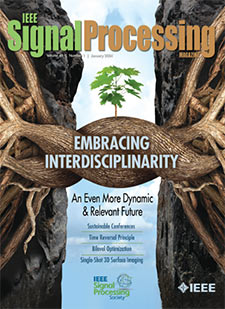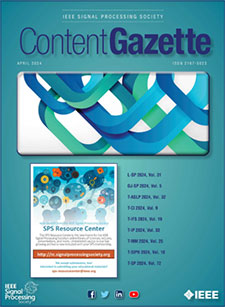- Our Story
- Publications & Resources
- Publications & Resources
- Publications
- IEEE Signal Processing Magazine
- IEEE Journal of Selected Topics in Signal Processing
- IEEE Signal Processing Letters
- IEEE/ACM Transactions on Audio Speech and Language Processing
- IEEE Transactions on Computational Imaging
- IEEE Transactions on Image Processing
- IEEE Transactions on Information Forensics and Security
- IEEE Transactions on Multimedia
- IEEE Transactions on Signal and Information Processing over Networks
- IEEE Transactions on Signal Processing
- IEEE TCI
- IEEE TSIPN
- Data & Challenges
- Submit Manuscript
- Guidelines
- Information for Authors
- Special Issue Deadlines
- Overview Articles
- Top Accessed Articles
- SPS Newsletter
- SigPort
- SPS Resource Center
- Publications Feedback
- Publications FAQ
- Blog
- News
- Dataset Papers
- Conferences & Events
- Community & Involvement
- Professional Development
- For Volunteers
- Information for Authors-OJSP
-
Home
Conferences Events IEEE JSTSP Article IEEE Signal Processing Magazine IEEE TIFS Article IEEE TMM Article IEEE TSP Article Jobs in Signal Processing Lectures Machine Learning Seasonal Schools Signal Processing News SPM Article SPS Distinguished Lectures SPS Newsletter Article SPS Webinar SPS Webinars SPS Webinar Series Webinar webinars
-
Our Story
What is Signal Processing?

The technology we use, and even rely on, in our everyday lives –computers, radios, video, cell phones – is enabled by signal processing. Learn More » -
Publications & Resources
-
SPS Resources
- Signal Processing Magazine The premier publication of the society.
- SPS Newsletter Monthly updates in Signal Processing
- SPS Resource Center Online library of tutorials, lectures, and presentations.
- SigPort Online repository for reports, papers, and more.
- SPS Feed The latest news, events, and more from the world of Signal Processing.
-
SPS Resources
-
Conferences & Events
-
Community & Involvement
-
Membership
- Join SPS The IEEE Signal Processing Magazine, Conference, Discounts, Awards, Collaborations, and more!
- Chapter Locator Find your local chapter and connect with fellow industry professionals, academics and students
- Women in Signal Processing Networking and engagement opportunities for women across signal processing disciplines
- Students Scholarships, conference discounts, travel grants, SP Cup, VIP Cup, 5-MICC
- Young Professionals Career development opportunities, networking
- Get Involved
-
Technical Committees
- Applied Signal Processing Systems
- Audio and Acoustic Signal Processing
- Bio Imaging and Signal Processing
- Computational Imaging
- Image Video and Multidimensional Signal Processing
- Information Forensics and Security
- Machine Learning for Signal Processing
- Multimedia Signal Processing
- Sensor Array and Multichannel
- Signal Processing for Communication and Networking
- Signal Processing Theory and Methods
- Speech and Language Processing
- Technical Working Groups
- More TC Resources
-
Membership
-
Professional Development
-
Professional Development
- Mentoring Experiences for Underrepresented Young Researchers (ME-UYR)
- Micro Mentoring Experience Program (MiME)
- Distinguished Lecturer Program
- Distinguished Lecturers
- Distinguished Lecturer Nominations
- Past Lecturers
- Distinguished Industry Speaker Program
- Distinguished Industry Speakers
- Distinguished Industry Speaker Nominations
- Industry Resources
- IEEE Training Materials
- Jobs in Signal Processing: IEEE Job Site
-
Career Resources
- SPS Education Program Educational content in signal processing and related fields.
- Distinguished Lecturer Program Chapters have access to educators and authors in the fields of Signal Processing
- PROGRESS Initiative Promoting diversity in the field of signal processing.
- Job Opportunities Signal Processing and Technical Committee specific job opportunities
- Job Submission Form Employers may submit opportunities in the area of Signal Processing.
-
Professional Development
-
For Volunteers
-
For Board & Committee Members
- Board Agenda/Minutes* Agendas, minutes and supporting documentation for Board and Committee Members
- SPS Directory* Directory of volunteers, society and division directory for Board and Committee Members.
- Membership Development Reports* Insight into the Society’s month-over-month and year-over-year growths and declines for Board and Committee Members
-
For Board & Committee Members
Popular Pages
Today's:
- Submit a Manuscript
- Information for Authors
- IEEE Transactions on Multimedia
- IEEE Transactions on Signal Processing
- IEEE/ACM Transactions on Audio Speech and Language Processing
- (MLSP 2024) 2024 IEEE International Workshop on Machine Learning for Signal Processing
- IEEE Transactions on Image Processing
- IEEE Signal Processing Letters
- Information for Authors-SPL
- IEEE Transactions on Signal and Information Processing over Networks
- IEEE Transactions on Information Forensics and Security
- Conferences & Events
- SPS Scholarship Program
- Publications & Resources
- Conference Call for Papers
All time:
- Information for Authors
- Submit a Manuscript
- IEEE Transactions on Image Processing
- 404 Page
- IEEE/ACM Transactions on Audio Speech and Language Processing
- IEEE Transactions on Information Forensics and Security
- IEEE Transactions on Multimedia
- IEEE Signal Processing Letters
- IEEE Transactions on Signal Processing
- Conferences & Events
- IEEE Journal of Selected Topics in Signal Processing
- Information for Authors-SPL
- Conference Call for Papers
- Signal Processing 101
- IEEE Signal Processing Magazine
Last viewed:
- IEEE Transactions on Image Processing
- Pragmatic Aspects of Discourse Production for the Automatic Identification of Alzheimer's Disease
- IEEE Open Journal of Signal Processing
- (DCC 2024) 2024 Data Compression Conference
- IEEE Transactions on Signal and Information Processing over Networks
- IEEE Transactions on Information Forensics and Security
- Reconfigurable Intelligent Surfaces Aided Robust Systems
- (SLT 2024) 2024 IEEE Spoken Language Technology Workshop
- (ICASSP 2025) 2025 IEEE International Conference on Acoustics, Speech and Signal Processing
- Deadline Extended: Call for Nominations for IEEE SPS Editors-in-Chief
- (ISBI 2024) 2024 IEEE International Symposium on Biomedical Imaging
- Conference Call for Papers
- Technical Working Groups
- Speech and Language Processing
- Interview with Chetan Arora, Associate Professor, IIT Delhi, India
What Should We Learn? For Faster AI, Mix Memory and Processing
You are here
Newsletter Menu
Newsletter Categories
Top Reasons to Join SPS Today!
1. IEEE Signal Processing Magazine
2. Signal Processing Digital Library*
3. Inside Signal Processing Newsletter
4. SPS Resource Center
5. Career advancement & recognition
6. Discounts on conferences and publications
7. Professional networking
8. Communities for students, young professionals, and women
9. Volunteer opportunities
10. Coming soon! PDH/CEU credits
Click here to learn more.
News and Resources for Members of the IEEE Signal Processing Society
What Should We Learn? For Faster AI, Mix Memory and Processing
If John von Neumann were designing a computer today, there’s no way he would build a thick wall between processing and memory. At least, that’s what computer engineer Naresh Shanbhag of the University of Illinois at Urbana-Champaign believes. The eponymous von Neumann architecture was published in 1945. It enabled the first stored-memory, reprogrammable computers—and it’s been the backbone of the industry ever since.
Now, Shanbhag thinks it’s time to switch to a design that’s better suited for today’s data-intensive tasks. In February, at the International Solid-State Circuits Conference (ISSCC), in San Francisco, he and others made their case for a new architecture that brings computing and memory closer together. The idea is not to replace the processor altogether but to add new functions to the memory that will make devices smarter without requiring more power.
Industry must adopt such designs, these e ngineers believe, in order to bring artificial intelligence out of the cloud and into consumer electronics. Consider a simple problem like determining whether or not your grandma is in a photo. Artificial intelligence built with deep neural networks excels at such tasks: A computer compares her photo with the image in question and determines whether they are similar—usually by performing some simple arithmetic. So simple, in fact, that moving the image data from stored memory to the processor takes 10 to 100 times as much energy as running the computation.
ngineers believe, in order to bring artificial intelligence out of the cloud and into consumer electronics. Consider a simple problem like determining whether or not your grandma is in a photo. Artificial intelligence built with deep neural networks excels at such tasks: A computer compares her photo with the image in question and determines whether they are similar—usually by performing some simple arithmetic. So simple, in fact, that moving the image data from stored memory to the processor takes 10 to 100 times as much energy as running the computation.
That’s the case for most artificial intelligence that runs on von Neumann architecture today. As a result, artificial intelligence is power hungry, neural networks are stuck in data centers, and computing is a major drain for new technologies such as self-driving cars.
“The world is gradually realizing it needs to get out of this mess,” says Subhasish Mitra, an electrical engineer at Stanford University. “Compute has to come close to memory. The question is, how close?”
Mitra’s group uses an unusual architecture and new materials, layering carbon-nanotube integrated circuits on top of resistive RAM—much closer than when they’re built on separate chips. In a demo at ISSCC, their system could efficiently classify the language of a sentence.
Shanbhag’s group and others at ISSCC stuck with existing materials, using the analog control circuits that surround arrays of memory cells in new ways. Instead of sending data out to the processor, they program these analog circuits to run simple artificial intelligence algorithms. They call this design “deep in-memory architecture.”
Shanbhag doesn’t want to break up memory subarrays with processing circuits, because that would reduce storage density. He thinks that doing processing at the edges of subarrays is deep enough to get an energy and speed advantage without losing storage. Shanbhag’s group found a tenfold improvement in energy efficiency and a fivefold improvement in speed when using analog circuits to detect faces in images stored in static RAM.
Mitra says it’s still unclear whether in-memory computing can provide a large enough benefit to topple existing architectures. He thinks its energy and speed must improve by 1,000 times to convince semiconductor companies, circuit designers, and programmers to make big changes.
Startups could lead the charge, says Meng-Fan Chang, an electrical engineer at the National Tsing Hua University, in Taiwan. A handful of startups, including Texas-based Mythic, are developing a similar technology to build dedicated AI circuits. “There is an opportunity to tap into smaller markets,” says Chang.
For Faster AI, Mix Memory and Processing: New computing architectures aim to bring machine learning to more devices
KatherineBourzac. For Faster AI, Mix Memory and Processing: New computing architectures aim to bring machine learning to more devices. Spectrum, April, 2018, pp. 12-13
Open Calls
Society News
Conference News
Initiatives & Trends
Publications News
SPS on Twitter
- DEADLINE EXTENDED: The 2023 IEEE International Workshop on Machine Learning for Signal Processing is now accepting… https://t.co/NLH2u19a3y
- ONE MONTH OUT! We are celebrating the inaugural SPS Day on 2 June, honoring the date the Society was established in… https://t.co/V6Z3wKGK1O
- The new SPS Scholarship Program welcomes applications from students interested in pursuing signal processing educat… https://t.co/0aYPMDSWDj
- CALL FOR PAPERS: The IEEE Journal of Selected Topics in Signal Processing is now seeking submissions for a Special… https://t.co/NPCGrSjQbh
- Test your knowledge of signal processing history with our April trivia! Our 75th anniversary celebration continues:… https://t.co/4xal7voFER
Home | Sitemap | Contact | Accessibility | Nondiscrimination Policy | IEEE Ethics Reporting | IEEE Privacy Policy | Terms | Feedback
© Copyright 2024 IEEE – All rights reserved. Use of this website signifies your agreement to the IEEE Terms and Conditions.
A not-for-profit organization, IEEE is the world's largest technical professional organization dedicated to advancing technology for the benefit of humanity.









